Small Home Theater Ideas: Transform Your Tiny Space into an Immersive Cinematic Escape
If you’ve been dreaming of turning that spare room, basement nook, or even a large closet into your very own private cinema, you’re in the perfect spot. I understand the unique challenges that come with designing a home theater in a smaller space, where every inch counts and smart choices are paramount.
In this comprehensive guide, I’ll walk you through a wealth of small home theater room design ideas specifically tailored for tight spaces. You’ll discover practical, budget-friendly tips I’ve personally used and researched, covering everything from selecting the optimal room and planning your budget to innovative solutions for seating, storage, and technology that will enhance your viewing experience without cluttering your precious square footage.
Ready to unlock the full potential of your small room and transform it into a cozy, functional, and immersive cinematic haven? Let’s dive in and start building your dream theater!
Getting Started with Your Small Home Theater Project
Designing a dedicated home theater, even in a compact room, offers numerous advantages. Beyond saving money and space compared to larger, more elaborate setups, these compact cinemas provide a uniquely cozy and intimate viewing environment. They also offer easier control over sound acoustics, making it simpler to achieve optimal audio. However, careful planning is crucial to sidestep common layout and technical pitfalls. A well-thought-out plan ensures your small theater is both functional and enjoyable.
Choosing the Right Room: Location, Location, Location
The foundation of any great small home theater lies in selecting the right room. Ideal spaces are those that are naturally closed off and quiet. Spare bedrooms, basements, finished attics, or even an unused den often serve as excellent candidates, as they can be easily adapted to become dedicated media rooms or additional living spaces. These areas offer superior control over ambient light and external sound, which are critical for an immersive experience.
- Light Control: Prioritize rooms with minimal windows, or be prepared to implement robust blackout solutions. Large windows can be a significant challenge unless you intend to completely block out all natural light with heavy drapes, blackout blinds, or even temporary panels.
- Noise Isolation: Evaluate external noise sources. A room adjacent to a busy laundry room, a high-traffic street, or a shared wall with noisy neighbors may not be ideal. Consider adding insulation or sound-dampening materials if noise is an issue.
- Dimensions and Comfort: While low ceilings are generally manageable, ensure the room feels comfortable and has sufficient depth to accommodate your screen, speakers, and seating without feeling cramped. A rectangular room often provides more flexibility for layout than a perfectly square one, but creative solutions exist for all shapes.
Budget Planning for Your Compact Cinema
Early budget planning is paramount for making informed decisions as you set up your small home theater. Begin by focusing your financial resources on the core components that deliver the most impact: a quality screen or projector, clear and balanced sound, and comfortable seating. These three elements form the backbone of any compelling home cinema experience.
Once these essentials are covered, you can gradually allocate funds for optional extras, such as decorative wall art, smart lighting systems, or specialized storage solutions. Opting for a do-it-yourself (DIY) approach allows you to work at your own pace, research components thoroughly, and select parts that perfectly fit your room and aesthetic preferences, often at a lower cost.
If professional assistance is required, seek out contractors or AV specialists who have proven experience working with small spaces. They can offer valuable insights into optimizing layouts and integrating technology efficiently. Keeping your initial project scope simple and focused on the essentials will make the entire process more manageable and prevent budget overruns.
Small Home Theater Room Design Ideas That Work
The following small room ideas are not just practical and smart; they are designed for maximum efficiency and ease of implementation. They will help you conserve space, maintain organization, and ultimately enjoy a superior viewing setup without the need for an expansive or custom-built room.
1. Corner-Mounted Screen Layout: Maximizing Angles

A diagonal screen setup is an ingenious way to make the absolute most of tight corners in a small room. By positioning your screen or TV in one corner, you naturally improve sightlines for all viewers and free up valuable wall space that can then be utilized for other furniture, storage, or decorative elements.
To implement this, simply mount your screen diagonally across a corner, and then position your primary seating arrangement directly opposite, also potentially angled. This layout is particularly effective in square rooms or spaces where one or more walls are partially obstructed or cannot be fully utilized. To further anchor the area and give it a clear purpose without consuming additional floor space, consider adding a small, subtle light fixture or an accent mat directly beneath the screen.
2. Two-Tier Platform Seating: Elevated Comfort
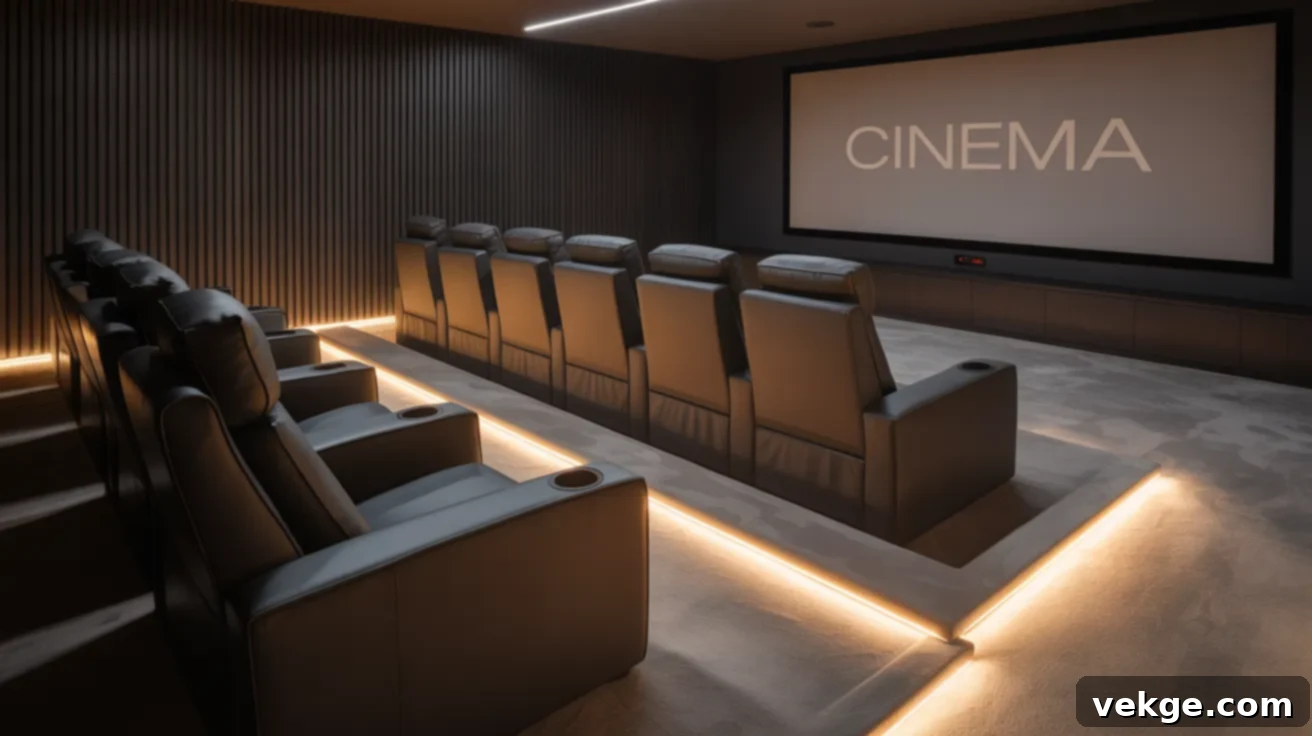
If your room can comfortably accommodate more than a single row of seating, introducing a small platform to elevate the second row is a game-changer. This simple addition prevents rear viewers from having their sightlines obstructed by those in front, ensuring everyone enjoys an unobstructed view of the screen. A basic wood riser, covered with soft carpet or rubber padding for sound dampening and comfort, works wonderfully.
For added functionality, consider designing the platform with internal storage compartments. This hidden space can be invaluable for stowing away blankets, extra cables, or even snacks. It’s crucial to keep the design compact and proportionate to the room to avoid making the space feel crowded. This solution is particularly solid for rooms that are approximately 12×15 feet or slightly larger, where a little vertical separation can make a big difference.
3. Wall-Hugging Recliners: Recline Without Space
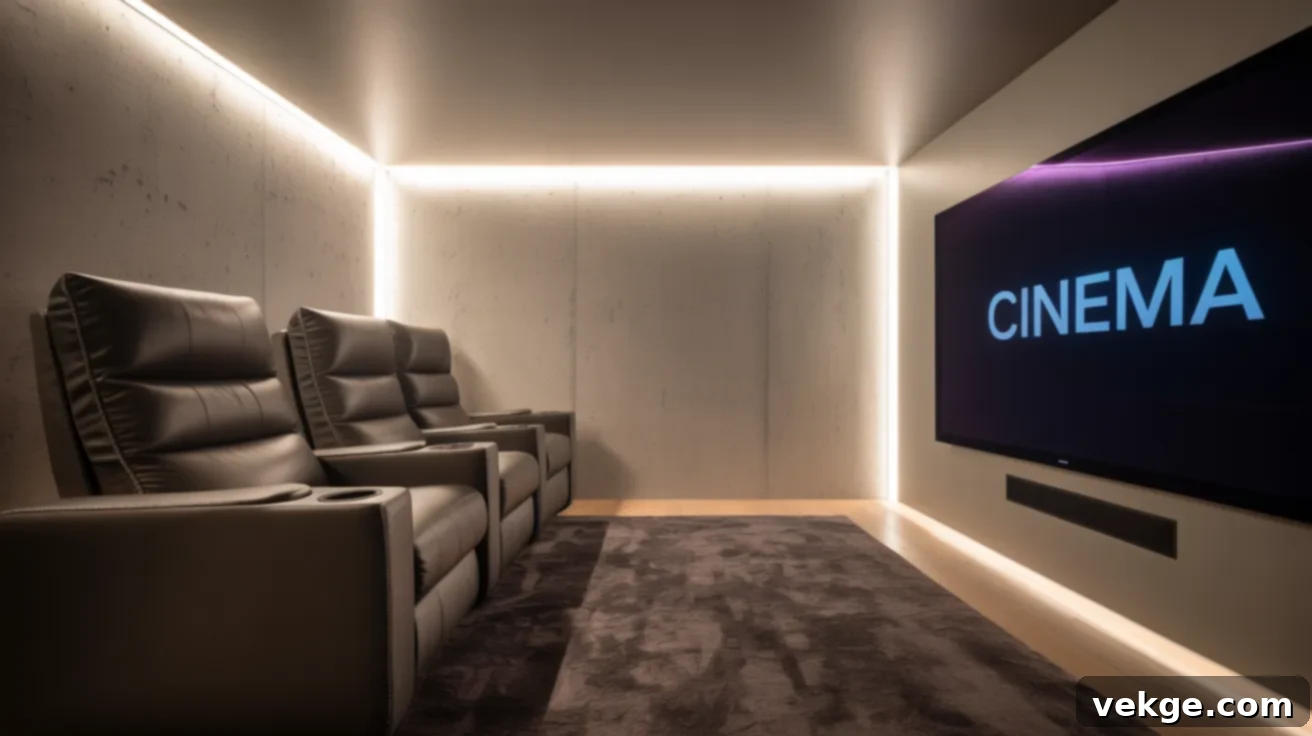
For small home theaters, traditional recliners can be space hogs, often requiring several inches behind them to fully recline. Wall-hugger recliners are specifically engineered to slide forward as they recline, meaning you can place them just a few inches from a wall without sacrificing their reclining functionality. These specialized seats are absolutely perfect for tight layouts where every inch of space is precious.
When selecting wall-huggers, look for styles that incorporate convenient features such as integrated cup holders, USB charging ports, or even hidden storage in the armrests. Opt for sets of two or three that can be placed side-by-side to maximize seating efficiency. Their blend of comfort and space-saving design makes them a highly popular and practical choice for any compact home cinema.
4. Custom Bench with Storage: Smart Multi-Functionality
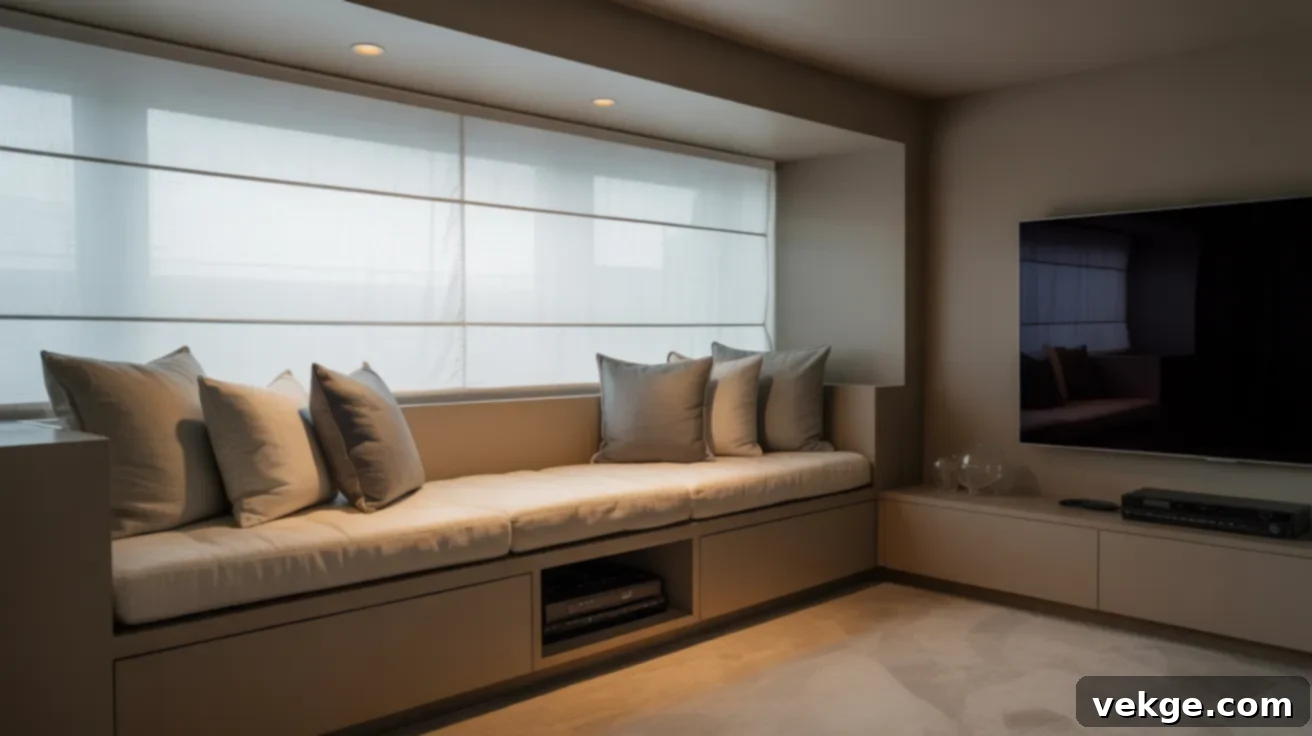
A custom-built bench seat running along one wall offers incredible double-duty functionality in a small home theater. During movie screenings, it provides comfortable seating, and when not in use, its interior can serve as discreet storage. You can easily construct one from basic wood panels, adding a comfortable, upholstered cushion on top for enhanced seating comfort.
This hidden storage is ideal for keeping cables, extra pillows, blankets, or movie night snacks out of sight. Position it under a window, beneath your screen setup, or along a back wall to maximize its utility. This option shines in rooms where there isn’t sufficient space for bulky individual chairs or additional cabinets, helping the room maintain a tidy, organized, and highly efficient feel.
5. Swivel Club Chairs: Flexible Seating Solutions
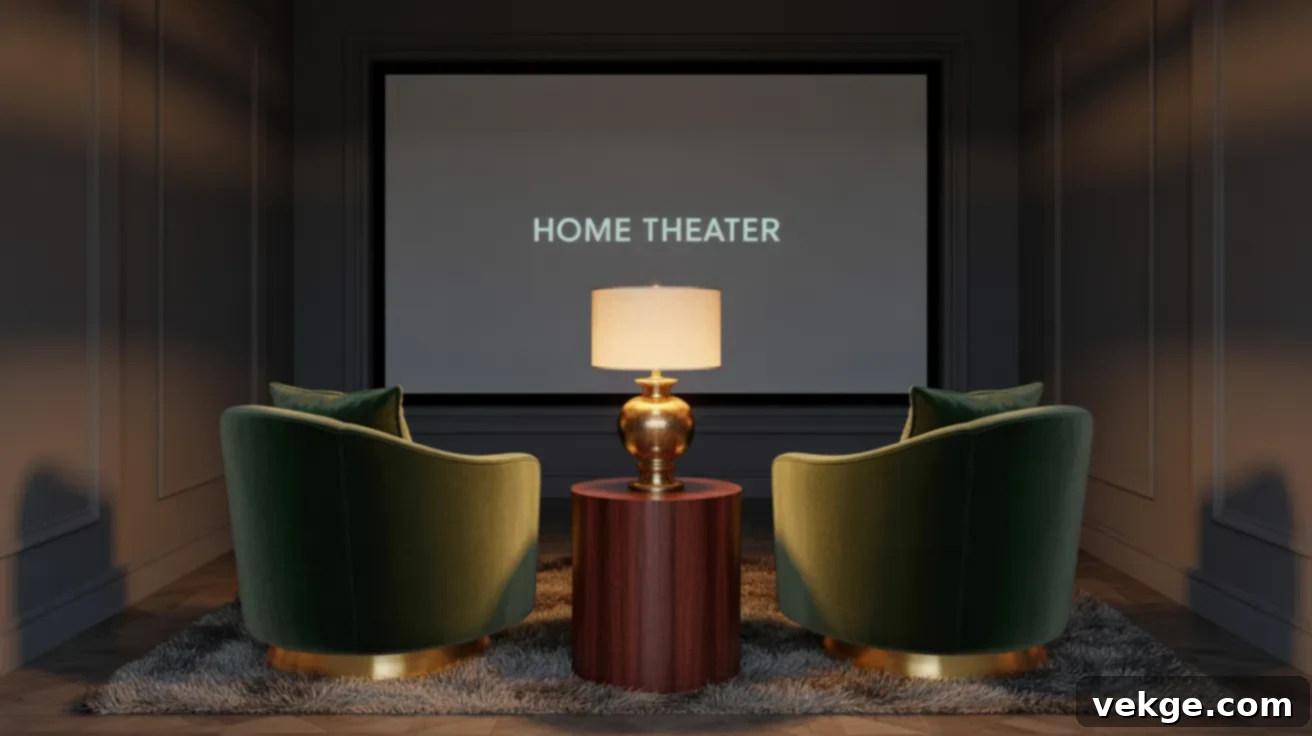
Swivel chairs introduce a wonderful degree of flexibility, allowing you to change your seating position with effortless ease. They are an excellent choice for small rooms that are designed to serve more than a single purpose. For instance, during daylight hours, these chairs can face a desk for work or a window for reading. When movie night arrives, a simple turn redirects them towards your screen.
Often, swivel chairs occupy less floor space than bulkier recliners and are considerably easier to reposition as needed. Look for models with round bases and softly cushioned backs for maximum comfort and style. They are particularly effective in corners or near walls where you desire more freedom in seating arrangement without committing to a fixed, forward-facing position.
6. Desk Behind Theater Seating: Dual-Purpose Room
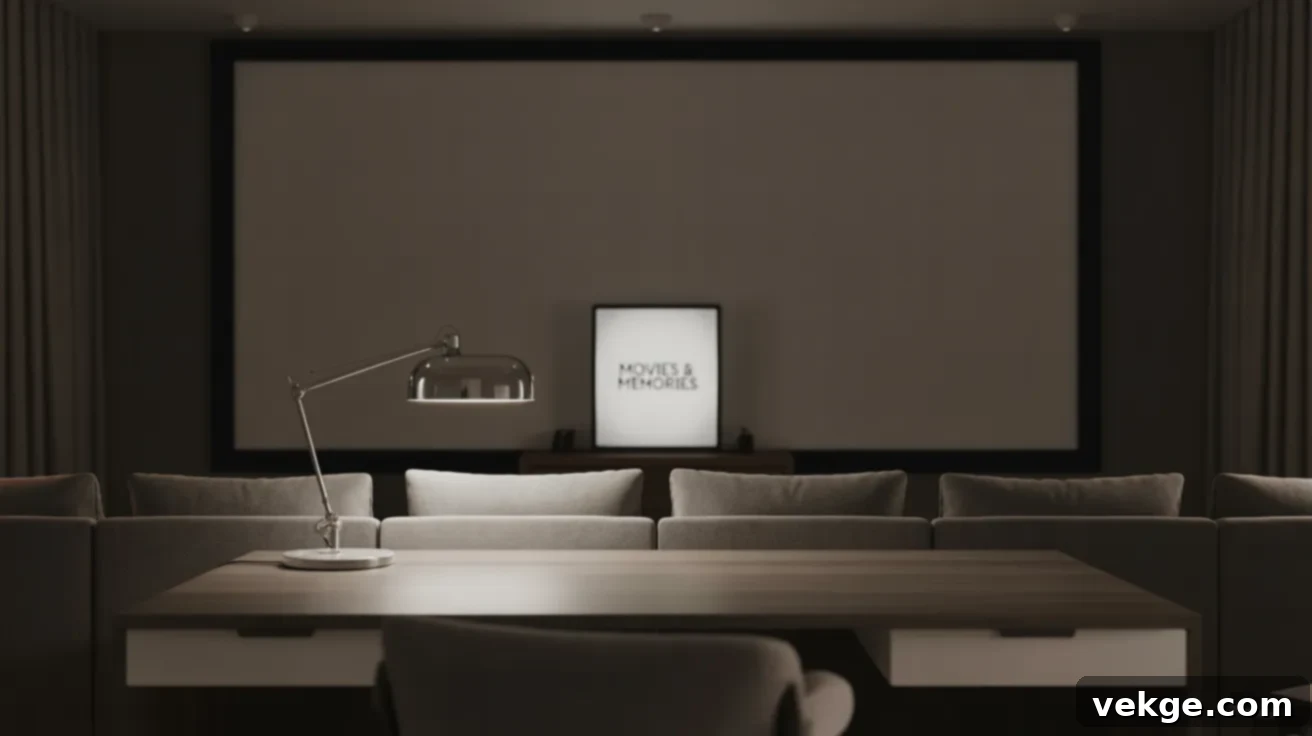
For rooms that need to function as both a home theater and a productive office or homework space, integrating a small, narrow desk directly behind your main theater seating is a brilliant space-saving strategy. Select a slim table that fits snugly along the back wall, ensuring it doesn’t extend too far into the viewing area.
Pair this desk with a compact stool or a slender chair that can be tucked completely underneath when not in use. This clever layout effectively separates your work zone from the entertainment area, allowing you to transition between tasks seamlessly. When it’s time for a movie, simply dim the lights and face forward – no need to move large furniture items or disconnect intricate wiring, maintaining a clean and functional setup.
7. Bookshelf-to-Bar Conversion: The Snack Hub

Transforming a tall, existing bookshelf into a dedicated snack bar is an incredibly resourceful way to enhance your small home theater. Re-purpose the shelves to store an array of drinks and snacks, ensuring popcorn, soda, and your favorite movie candies are always conveniently within reach without having to constantly trek to the kitchen.
Elevate the experience by adding stick-on LED lights or a small spotlight to illuminate the shelves, creating an inviting display. You can also neatly store napkins, serving trays, or reusable cups on these shelves. This setup works exceptionally well in corners or positioned strategically between chairs, providing easy access to treats without adding bulk to the room or requiring the purchase of a full, dedicated cabinet or bar unit.
8. Motion-Activated Floor Lighting: Safety and Ambiance
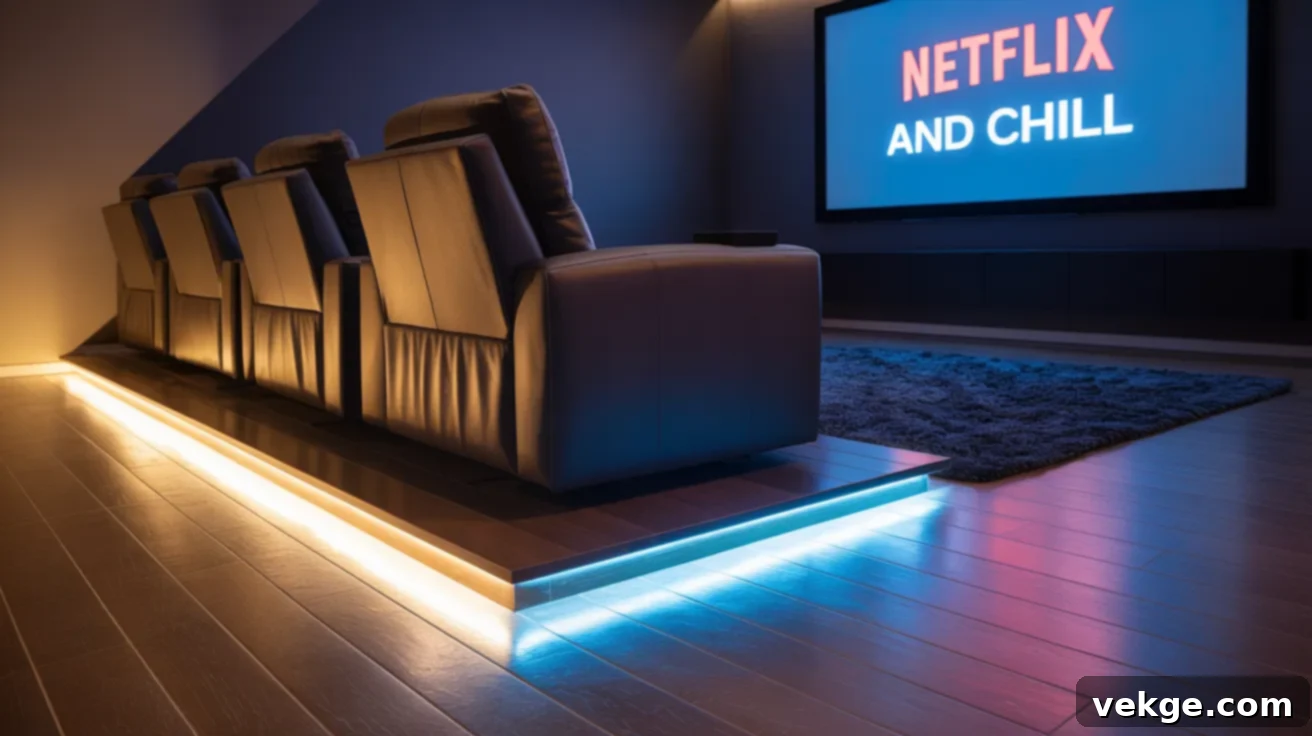
For small home theater rooms, where navigating in low light can be tricky, motion-activated floor lighting is a game-changer. These intelligent lights automatically illuminate when movement is detected, allowing individuals to safely walk around or find their seats without fumbling for a switch or disrupting the movie’s immersion.
Strategically place these lights along the base of walls, under seating, or along any steps to gently guide movement in a darkened room. They are often incredibly easy to install, with many options running on batteries or plugging into standard wall outlets, eliminating the need for complex wiring. The soft, unobtrusive glow lights the path effectively without casting harsh light or detracting from the cinematic experience.
9. Themed Fabric Wall Panels: Acoustic and Aesthetic Harmony
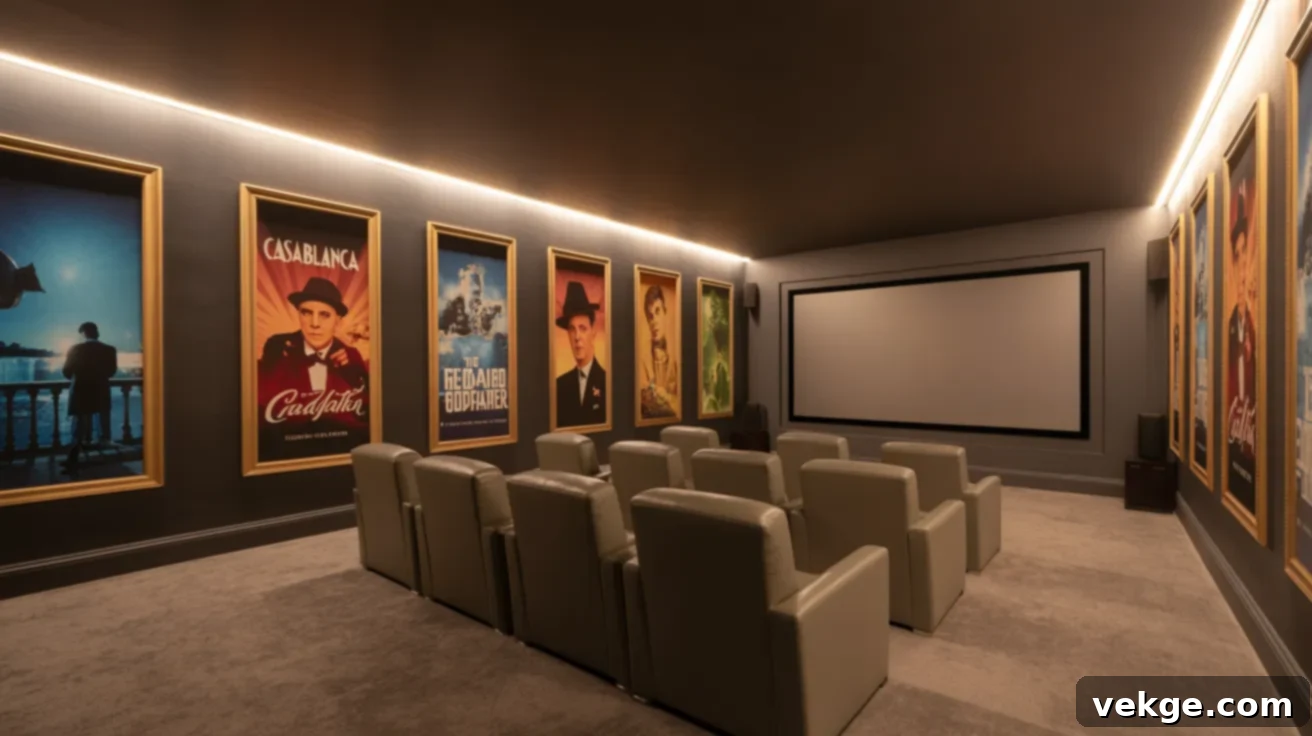
Elevate both the aesthetics and acoustics of your small home theater by installing foam panels covered with fabric that complements your chosen movie theme or color scheme. Whether you opt for elegant solid dark colors or vibrant movie-themed prints, these panels serve a dual purpose: they significantly improve sound quality by absorbing echoes and simultaneously act as stylish decorative elements.
These panels can be framed for a more polished look or simply mounted using adhesive strips for a quick and easy DIY project. This setup effectively dampens sound reflections, making dialogue clearer and music richer, leading to a more immersive audio experience. It’s a remarkably simple and effective way to enhance both the visual appeal and the acoustic performance of your walls without requiring extensive renovations.
10. Short-Throw Projector with Ceiling Mount: Big Screen, Small Space
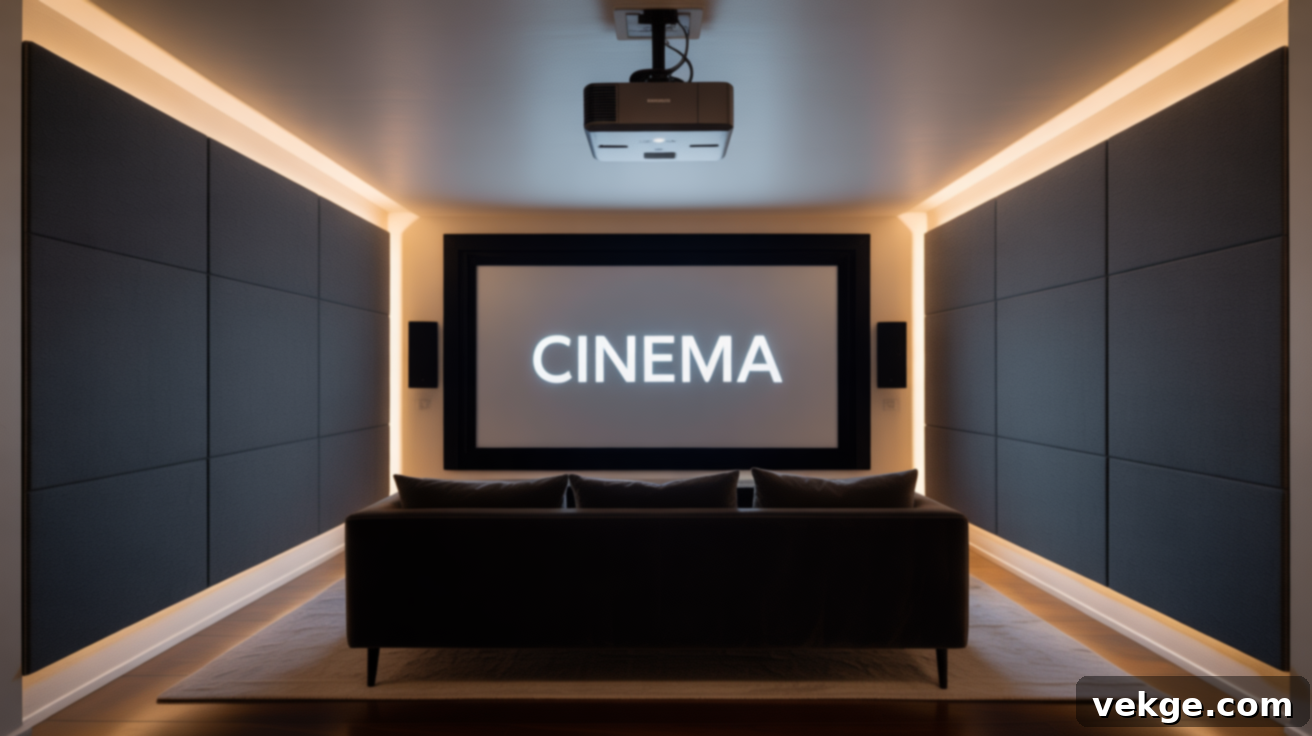
A short-throw projector is an absolute essential for rooms with limited space, offering the ability to project a large, high-quality image from a very short distance. Unlike traditional projectors, it can be mounted much closer to the screen or wall, virtually eliminating the need for lengthy cable runs across the floor, which can be a trip hazard and visual clutter.
Pairing it with a ceiling mount saves even more floor and table space, contributing to a cleaner, more professional look. When installing, ensure the projector is perfectly aligned to match the screen’s height and width for optimal picture quality. This setup excels in rectangular rooms, delivering a truly immersive, wall-filling image even from a compact throw distance, making your small room feel significantly larger.
11. Slide-Out AV Equipment Drawer: Concealed Tech
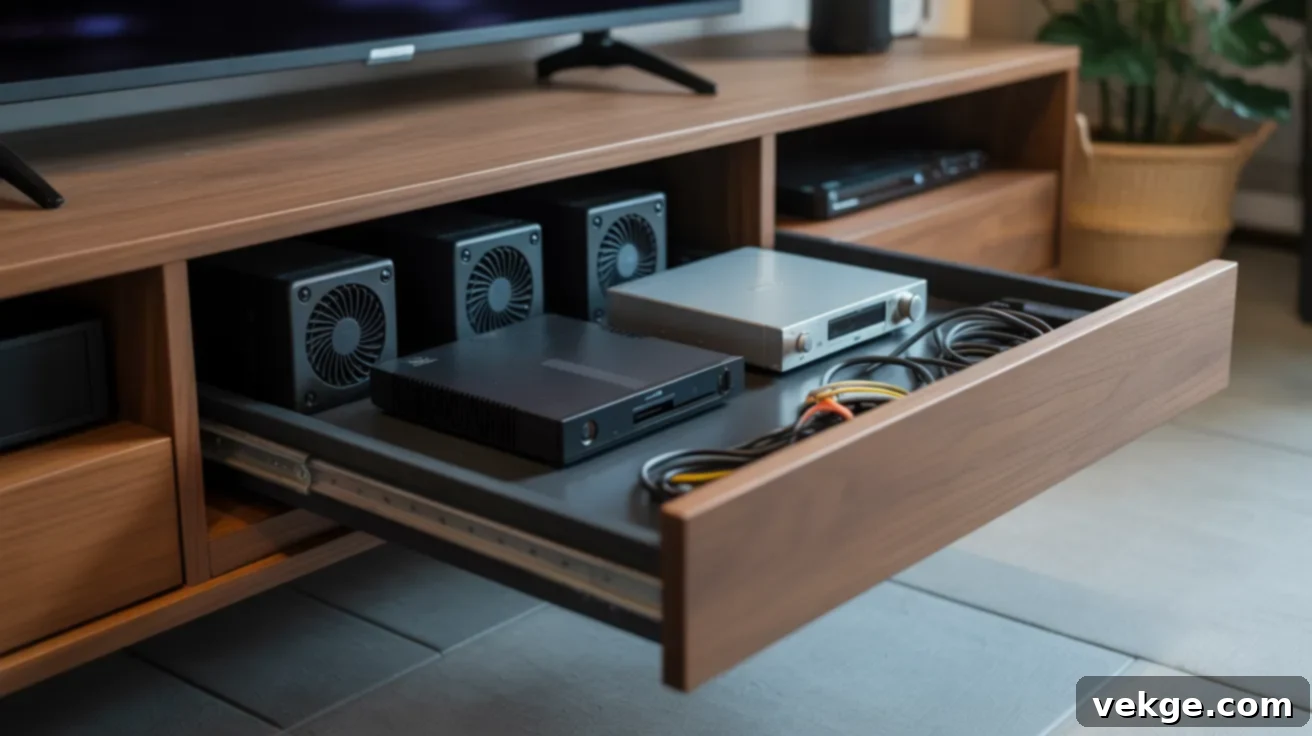
To maintain a sleek and uncluttered aesthetic in your small home theater, integrate your electronics into a slide-out drawer or cabinet system. This ingenious solution keeps unsightly receivers, Blu-ray players, game consoles, and other gear neatly tucked away, ensuring the front of your room remains clear and visually appealing. Yet, it still provides easy access for maintenance or connecting new devices.
Remember to incorporate strategic holes in the back of the drawer for efficient cable management and to allow for proper ventilation to prevent heat buildup, which can damage electronics. This idea is fantastic for hiding wires and giving your room a polished, finished feel. It can be custom-built into a bench, a side cabinet, or even discreetly integrated directly below your screen setup for ultimate convenience.
12. Closet-to-Theater Makeover: The Micro Cinema
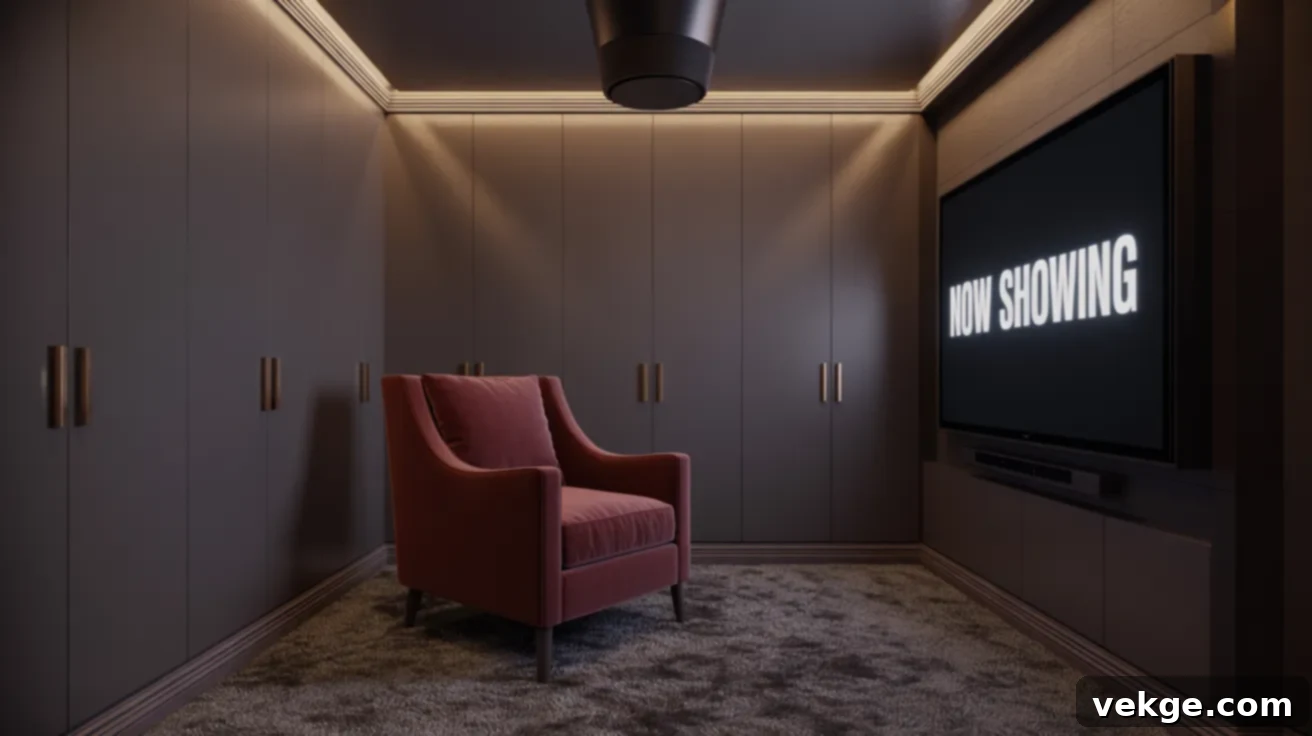
Don’t underestimate the potential of an underutilized walk-in closet! Transforming it into a tiny, yet fully functional, home theater is a surprisingly effective way to create a private viewing sanctuary. Simply install a screen or a wall-mounted TV on one end and furnish the space with a single comfortable chair, a plush loveseat, or even oversized bean bags.
Utilize dark paint colors or heavy, light-blocking curtains to ensure complete darkness. Mount compact speakers on the closet walls or ceiling to save precious floor space. This setup is ideal for solo viewing, immersive gaming, or a cozy couple’s movie night. It offers unparalleled quietness and privacy, utilizing space you might otherwise overlook. The beauty of this approach is that you don’t need to reconfigure an entire room; focus solely on making this compact nook comfortable, functional, and straightforward.
Designing for the Senses: Light, Sound & Color in Small Spaces
In small home theater environments, even seemingly minor adjustments to lighting, sound, and color can dramatically improve the mood, acoustic quality, and overall picture clarity. Thoughtful choices in these areas will help your room feel more focused, comfortable, and perfectly suited for extended viewing sessions.
Lighting Tips for Immersive Viewing
Strategic lighting is key to creating the right ambiance and reducing eye strain. Soft, ambient lighting helps your eyes adjust gracefully during dark and bright movie scenes, fostering a relaxed and calm mood. LED strip lights installed behind your screen or TV provide excellent bias lighting, reducing eye fatigue without drawing attention away from the main display.
Consider dimmable wall sconces or smart lights with remote controls or app integration, allowing you to precisely adjust brightness levels without leaving your seat. Opt for warm white tones (around 2700K-3000K) over harsh white or blue lights, which can disrupt the cinematic atmosphere. Additionally, low-level floor lighting, such as motion-activated strips or puck lights, can gently guide movement in the dark without being overly bright or distracting. Many stick-on and battery-powered options are available, making installation simple without complex wiring.
Acoustic Treatments on a Budget
Improving the sound quality in your small home theater doesn’t have to break the bank. Several budget-friendly acoustic treatments can significantly enhance your audio experience:
- Thick Curtains and Drapes: Installing heavy, floor-to-ceiling curtains on windows not only helps block out external light but also effectively absorbs echoes and outside noise. Velvet or other thick fabrics are particularly good for this.
- Area Rugs: Hard floors can cause sound to bounce excessively, leading to echoes and a muddy sound profile. A plush area rug can dramatically reduce this effect, absorbing sound and creating a warmer, more balanced acoustic environment.
- Foam Acoustic Panels: Widely available and easy to install, foam tiles are a popular choice for treating walls. For a more aesthetically pleasing look, consider framing them with wood or covering them with an attractive acoustic fabric.
- Bookshelves: Even simply filling a bookshelf with books, DVDs, or other soft, irregular objects can help diffuse sound waves and soften reflections in a room.
Focus your efforts on treating the walls and corners where sound tends to reflect the most, as these are often the primary culprits for poor room acoustics.
Choosing the Right Paint Colors
The color of your room’s walls plays a critical role in minimizing light reflection and allowing your screen to truly stand out. Stick with flat or matte finishes in deep, dark shades like charcoal gray, navy blue, forest green, or rich brown. These non-reflective finishes are crucial because they absorb ambient light from the screen, preventing it from bouncing back and creating distracting glare that degrades picture quality.
While lighter ceilings can sometimes work, maintaining rich and deep wall tones is essential for creating a truly focused viewing environment. Absolutely avoid gloss or semi-gloss paints, as their reflective properties will amplify glare and detract from your immersive experience. A consistent, dark wall color also helps the room feel calm, pulled together, and dedicated to its cinematic purpose.
Essential Tech Setup for Small Theaters
The right technological setup is paramount for maximizing your small room’s potential. Carefully selecting your display, optimizing speaker placement, and implementing smart storage solutions will keep your space neat, functional, and easy to use without overwhelming its limited footprint.
Screen vs. Projector vs. TV: Making the Right Display Choice
For compact rooms, understanding the pros and cons of each display option is crucial to avoid wasted space and ensure the best viewing experience. Use this quick guide to compare:
| Option | Best For | Pros | Cons |
|---|---|---|---|
| Short-Throw Projector | Small spaces with clear wall access; cinematic feel | Huge image from close distance; declutters wall space (when off) | Requires controlled lighting; potential for fan noise; screen needed for best results |
| Wall-Mounted TV | Simple setups with fewer devices; mixed-use rooms | Easy to install; bright image in ambient light; less setup complexity | Fixed size; can dominate a small wall; reflects light more than a projector screen |
| Pull-Down Screen | Rooms used for other tasks (e.g., office, gym) | Hides away when not required; works well with projectors for a cinematic feel | Requires projector; manual pull-down can be cumbersome; motorized versions add cost |
Speaker Placement & Wiring Tips for Optimal Sound
Proper speaker and wire setup significantly impacts both sound quality and the visual cleanliness of your room. Keep your small home theater sleek and acoustically balanced with these tips:
- In-Ceiling or In-Wall Speakers: These are ideal for saving space and eliminating floor clutter. They provide a discrete, built-in look while delivering excellent sound.
- Ear-Level Placement: For the front left, right, and center channels, ensure speakers are placed at ear level when you are seated. This ensures balanced and natural-sounding audio.
- Wireless Models: Where possible, opt for wireless speakers to bypass cable mess and reduce the need for wall drilling. Modern wireless systems offer surprisingly good audio quality.
- Hidden Wiring: Run wires discreetly through baseboard channels, behind shelves, or inside walls for a clean, professional setup. Cable management sleeves can also tidy up visible cables.
- Avoid Corner Placement: Do not place speakers directly in room corners, especially subwoofers. This can cause sound to become overly boomy or distorted due to bass buildup.
Storage & Media Equipment Placement: Organized Efficiency
Effective storage is simple if planned from the outset. Maximizing vertical space and integrating multi-functional furniture are key:
- Floating Shelves: Utilize wall-mounted floating shelves to hold your Blu-ray player, gaming console, or other small gear. This frees up valuable floor space.
- Low AV Cabinet: A low-profile AV cabinet positioned directly under your screen is perfect for centralizing wires, storing equipment, and providing a stable display surface for decor.
- Under-Seat Storage: If you’ve incorporated a custom bench or platform riser, build in under-seat storage compartments for items like remotes, cables, or your movie collection.
- Ventilation: Always ensure adequate ventilation for any electronics stored in drawers or enclosed cabinets to prevent overheating, which can shorten component lifespans. Add small fans or open backs if necessary.
Finishing Touches & Personal Style
A small home theater truly comes alive when you infuse it with personal touches that reflect your taste. Simple decor choices and practical extras can transform the space, making it more welcoming and perfectly suited for both casual everyday use and special movie nights.
Wall Decor, Posters, & Theme Concepts: Express Your Passion
Adding thoughtful wall decor is essential for infusing personality into your home theater setup. Choose themes that resonate with your interests, whether it’s classic Hollywood glamour, modern sci-fi, vintage cinema, or a specific film franchise like Marvel or Star Wars. Movie posters can be framed for a professional look or printed on canvas for easy, lightweight hanging.
An incredibly smart option is to use framed acoustic panels. These not only serve as stylish decorative elements but also significantly improve sound quality by absorbing reflections. Select panels in dark or muted tones to avoid creating glare from the screen. Additionally, wall-mounted shelves adorned with action figures, vintage film reels, or movie memorabilia can give the room a focused and unique feel without encroaching on precious floor space.
Furniture & Snack Bar Setup: Comfort Meets Convenience
Comfort and readily available snacks are intrinsically linked to the ultimate movie night experience. Enhance your small theater with these practical additions:
- Mini Fridge: A compact mini-fridge positioned conveniently near your seats ensures cold drinks are always within arm’s reach, eliminating mid-movie trips to the kitchen.
- Rolling Snack Cart: A versatile rolling snack cart, stocked with popcorn, candy, and napkins, can be easily moved between rooms or neatly stored in a corner when not in use.
- Integrated Storage: For a more discreet approach, consider a custom drawer built directly into your media cabinet or a bench. This keeps snacks and amenities close at hand without adding any visual clutter.
Aim to match furniture finishes and styles to create a cohesive and balanced look within the space. Always choose pieces that are appropriately sized to avoid overcrowding the room, ensuring comfort and functionality are maintained.
Conclusion: Your Small Room, Your Big Screen Experience
You absolutely do not need an expansive mansion or a dedicated large room to create an incredible home cinema experience. With the diverse range of small home theater room design ideas and practical tips I’ve shared, you are well-equipped to build a space that perfectly fits your unique dimensions and feels just right for your viewing pleasure.
I sincerely hope you’ve discovered innovative ideas you’re eager to try, whether it’s implementing a clever two-tier seating arrangement, integrating hidden storage solutions, or selecting a space-saving short-throw projector. Remember, the best design is one that works best for your specific room and personal preferences. Don’t be afraid to experiment and truly make it your own.
If you’re now feeling inspired and ready for even more actionable tips to help you craft a space you truly love, I invite you to explore my other blogs on the website. A wealth of additional insights and creative solutions awaits you there!
